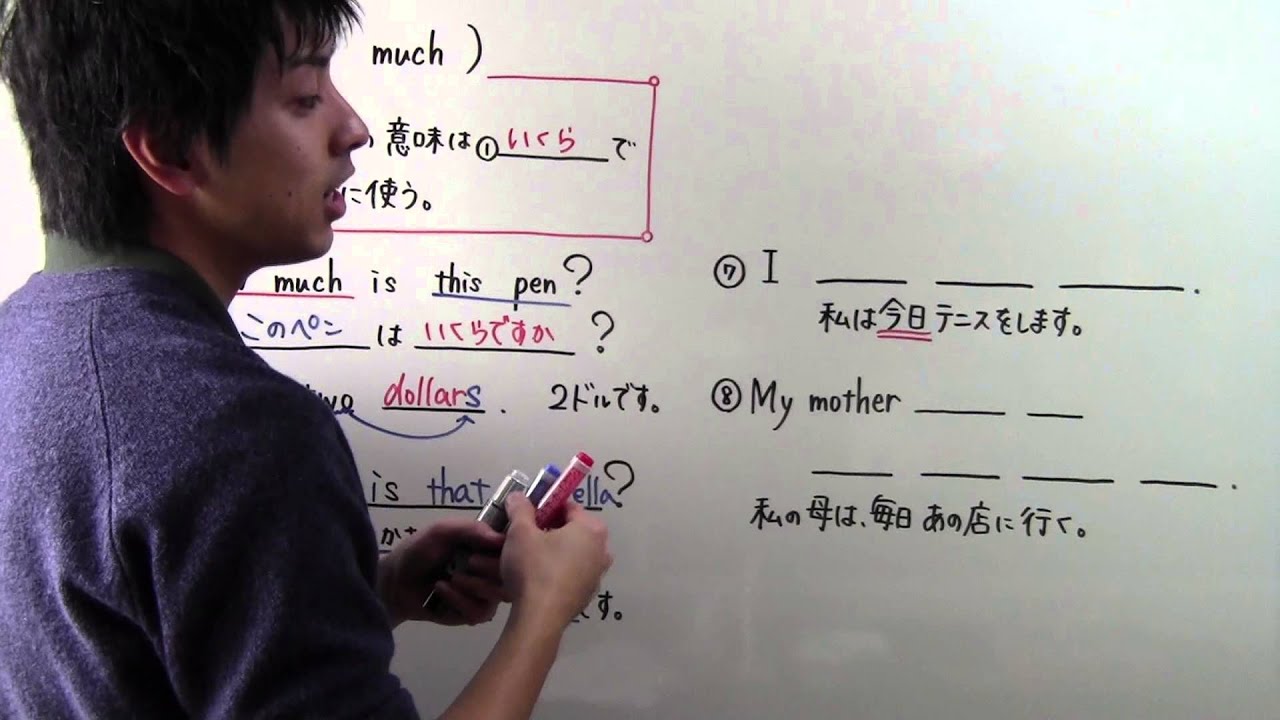問題文全文(内容文):
『2つ以上のもの』を表すなら、
①____の最後に②か③をつける。
1・・・④____
2・・・⑤____
3・・・⑥____
4・・・⑦____
5・・・⑧____
6・・・⑨____
7・・・⑩____
8・・・⑪____
9・・・⑫____
10・・・⑬____
⑭I have ____ ____.
私は一冊の本を持っている。
⑮I have ____ ____.
私は二冊の本を持っている。
⑯I ____ ____ ____.
私は3つの腕時計を持っている。
⑰あなたはいくつかのカバンを持っていますか?
____ ____ ____ ____ ____?
→⑱(返事)Yes,Ihave ____ ____.
はい。私は5つのバックを持っています。
⑲____ ____ ____.
いっしょに行こう。
⑳____ ____ ____ ____ ____ ____.
私たちは水曜日に6時間授業がある。
『2つ以上のもの』を表すなら、
①____の最後に②か③をつける。
1・・・④____
2・・・⑤____
3・・・⑥____
4・・・⑦____
5・・・⑧____
6・・・⑨____
7・・・⑩____
8・・・⑪____
9・・・⑫____
10・・・⑬____
⑭I have ____ ____.
私は一冊の本を持っている。
⑮I have ____ ____.
私は二冊の本を持っている。
⑯I ____ ____ ____.
私は3つの腕時計を持っている。
⑰あなたはいくつかのカバンを持っていますか?
____ ____ ____ ____ ____?
→⑱(返事)Yes,Ihave ____ ____.
はい。私は5つのバックを持っています。
⑲____ ____ ____.
いっしょに行こう。
⑳____ ____ ____ ____ ____ ____.
私たちは水曜日に6時間授業がある。
単元:
#英語(中学生)#中1英語#名詞・代名詞の複数形、How many~?、someとany
指導講師:
とある男が授業をしてみた
問題文全文(内容文):
『2つ以上のもの』を表すなら、
①____の最後に②か③をつける。
1・・・④____
2・・・⑤____
3・・・⑥____
4・・・⑦____
5・・・⑧____
6・・・⑨____
7・・・⑩____
8・・・⑪____
9・・・⑫____
10・・・⑬____
⑭I have ____ ____.
私は一冊の本を持っている。
⑮I have ____ ____.
私は二冊の本を持っている。
⑯I ____ ____ ____.
私は3つの腕時計を持っている。
⑰あなたはいくつかのカバンを持っていますか?
____ ____ ____ ____ ____?
→⑱(返事)Yes,Ihave ____ ____.
はい。私は5つのバックを持っています。
⑲____ ____ ____.
いっしょに行こう。
⑳____ ____ ____ ____ ____ ____.
私たちは水曜日に6時間授業がある。
『2つ以上のもの』を表すなら、
①____の最後に②か③をつける。
1・・・④____
2・・・⑤____
3・・・⑥____
4・・・⑦____
5・・・⑧____
6・・・⑨____
7・・・⑩____
8・・・⑪____
9・・・⑫____
10・・・⑬____
⑭I have ____ ____.
私は一冊の本を持っている。
⑮I have ____ ____.
私は二冊の本を持っている。
⑯I ____ ____ ____.
私は3つの腕時計を持っている。
⑰あなたはいくつかのカバンを持っていますか?
____ ____ ____ ____ ____?
→⑱(返事)Yes,Ihave ____ ____.
はい。私は5つのバックを持っています。
⑲____ ____ ____.
いっしょに行こう。
⑳____ ____ ____ ____ ____ ____.
私たちは水曜日に6時間授業がある。
投稿日:2013.06.25






